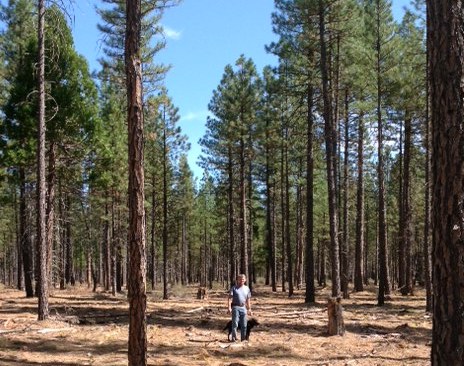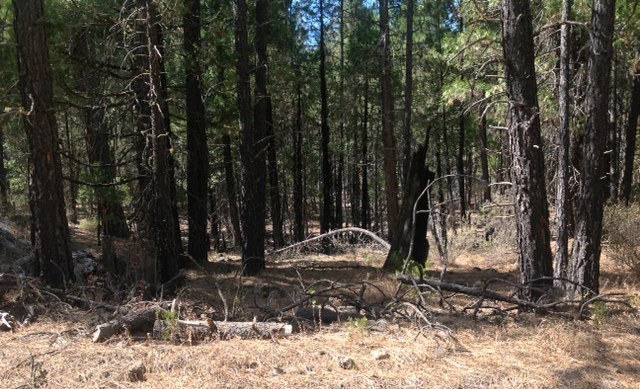Will Forest Service Copy Rancher’s Zero-Cost Forest Management Plan?
By: Amos S. Eno
Posted on:09/23/2012 Updated:09/28/2012California rancher & forest owner Peter Stent is working hard to help USDA’s Forest Service fight fire (and ultra-enviros) with common-sense forest management.
California rancher & forest owner Peter Stent is working hard to help USDA’s Forest Service fight fire (and ultra-enviros) with common-sense forest management.
In northern California, with Modoc National Forest to the north, Shasta National Forest to the west and Lassen National Forest to the south, Peter and Nora Stent’s Thousand Springs Ranch in Fall River Mills has plenty of surrounding reasons to work closely with USDA’s Forest Service.
Peter Stent wants to set a great example for the Forest Service and for other landowners. With expert guidance from retired Forest Service forester Rich Coakley, based on their extensive discussions, this year Stent thinned 160 of his 800 acres of forest at the ranch. Stent opted for a conservative plan, leaving about 20% more trees per acre than recommended by his forester, because “We can always go back and thin out more trees in future years if conditions warrant.”
[Rich Coakley explains more about the benefits of thinning in my Wildfires Spread because Congress & Enviros “Can’t See the Forest for the Trees” blog.]
To monitor over the long term what thinning can accomplish, Stent has established 23 research plots, each one-tenth of an acre, within the 160 acres of thinned forest. For each research plot, he explains, “we record all the vegetation inside that plot and our purpose is to monitor over time any changes that occur.”
On the Stents’ Thousand Springs Ranch in California – thinned and unthinned,
fire-proof vs. fire-prone:


Stent says “My goals in this thinning were to deal with being overstocked, way overstocked, and that’s because of fire suppression over the years. We do have some disease problems, and obviously I’ve been eliminating all the diseased trees. But it’s really because we’ve got too darn many trees per acre. We took out approximately half the trees. On average there were 324 trees per acre and we thinned on average to 153 trees. They would be clustered in tight clusters. So of course they compete against each other and kill each other off because they compete for the water and the nutrients. And so I wanted to get it back to a healthy condition, which would mean that there would be more light, more diversity in terms of plants and trees and we’d provide better feed for all forms of wildlife. We’re going for as much diversity as possible. In unthinned forests where it’s so thick you can hardly tell the sun’s out, there’s no way for the understory to be very healthy. But if you can let some light in there, I get the browse species coming back. It’s a big difference. ”
For his next step, this fall Stent plans a low-intensity controlled fire on the 160 acres to clear away any remaining forest-floor fuel. He explains that “I clearly want to reduce the fire hazard. We will run a fire through there this coming fall to clean up any excess litter. It should be a very cool fire, and then if we ever did have a ground fire in the area, that would be an easy place to defend because there’s going to be a lot less biomass and there won’t be any dead biomass out there. . . Once you clean that up, the fire regime out here should be somewhere between 7 to 10 years for repeated controlled fires. And we’ve gone over 100 years with no fires.”
This veteran conservationist says “I want to learn, I want to use my land as a demonstration plot for my neighbors. I adjoin some Forest Service parcels and I’ll be meeting with the Forest Service . . . I’m going to show them how their property is compared to mine.”
Stent blames forest problems on a century of wrong-headed fire suppression which came from forgetting the past: “The Indians knew how to manage this land better than we do. We have all the science but the Indians really knew how to manage it because they used to light the Sierras off every fall, it’s documented.”
“The problem is that the less informed environmentalists use a lot of the laws to their advantage, to basically stop everything. I don’t think they accept that these systems have been managed by man since the beginning of time. But at the turn of the 19th and beginning of the 20th century, we had this no-burn policy, and look at the mess it’s created.” Part of the mess, he points out, is that “Some environmentalists out here in California are too dogmatic, self righteous and intransigent, with the result that the Forest Service in my region spends about 30 to 35% of their budget on litigation as opposed to forest management.”
The immediate good news from Stent’s thinning experiment is that Stent did it “at zero cost for me, because the operator took all the chips to a co-gen plant and he kept all the proceeds” – proceeds which were enough to cover “using shears, not hot saws, so the fire danger was reduced” and handling removals carefully to avoid damaging the land.
Not only zero cost, Stent says, but also “it’s indirect income, because if that land ever burned over and I had to go in and rehab, it would cost me a fortune. So it’s foregone expense in the future.” Stent believes that the Forest Service could also enjoy zero cost up front, along with foregone expenses for fire fighting and subsequent remediation.
“So far, I’m ecstatic about the results,” Stent says, already planning to thin more of his 800 acres of forest. “My goal for future ecosystem-scale conservation is that I would like to be an early adopter, so that other people would follow suit. I think we have tremendous opportunity through the whole northern California watershed to greatly improve our water management and the health of our forests and to reduce our catastrophic wildfires. Honestly, I’d rather be on my 160 acres in a wildfire than a lot of my neighboring forests because I think I could control the situation. It won’t crown out. Instead, it will creep through and we could control it. . . We can control these wildfires in less dense forests much better than we can in these overgrown forests with lots of dead stuff on the ground and a lot of standing dead trees.”
As for his Forest Service neighbors, he says “they all know what they need to do, they just can’t get it done. What we need is to find the entrepreneurs inside the Forest Service who are willing to say, you know, this is the right thing to do with the land, the heck with the environmentalists, and just go do it on small scale. They don’t have to do 10,000 acres at one time. Go do 150 acres, do 80 acres, just do it.”
Stent’s hopeful that changes are coming because “There’s some very good thinking among the environmental groups.” He singles out the Pacific Forest Trust and the Environmental Defense Fund as groups which “get it” and are working with private landowners to promote sensible forest management practices and to help keep these lands as working landscapes.
Stent’s also hopeful thanks to the information provided by the Private Landowner Network. “I have it on my computer here and I read a lot of stuff on PLN,” he says. This information has helped him not only with his ranch and forest management but with his work in putting “over 10,000-plus acres in conservation easements.” He explains that with the majority of landowners near or even well beyond retirement age, “we have to start thinking about transitions and having easements on our properties as an important part of estate planning. . . I hope they use their heads back in Washington so that we can preserve some of these larger properties through estate tax law changes.”
Stent adds another reason for better forest management, based on Terry Anderson’s Wall Street Journal article “Environmental Protection up in Smoke.” The Sept. 17 article points out that not only are most National Forests fire hazards but also in these forests, “dense conifer canopies intercept rain and snow, with 30% lost to evaporation instead of soaking into the ground or flowing into rivers.” Stent reasons that “When water is going to be the biggest issue in the West, the more efficiently we can have our watersheds operate, the more water they can put into our groundwater aquifers, the better we all are, rather than lose 30% through evaporation because it doesn’t get through an overstocked forest to the forest floor.”
<><><><><><>
Feedback
re: Will Forest Service Copy Rancher’s Zero-Cost Forest Management Plan?By: Pam Giacomini on: 10/02/2012Great job Peter, and a great message! I don't know if you've heard of the work we are doing as the Burney Hat Creek Community Forest and Watershed Group, but we are working with the Forest Service to do thinning and harvest. A lot of work has occurred already, with much more planned over the upcoming years.
re: Will Forest Service Copy Rancher’s Zero-Cost Forest Management Plan?
By: Bob Williams CF on: 10/02/2012
This is a great story and shows that this situation is found from coast to coast. Here in southern New Jersey, forward thinking landowners are thinning their pine forests as well - to protect their forested watersheds for their cranberry farms! How we get government to open its eyes and minds to follow the lead of these private working lands, I do not know!
Thank you Mr. Stent, for joining and leading in this effort!!
Bob Williams CF
Certified Forester
 Sign In
Sign In
 Sign In
Sign In
